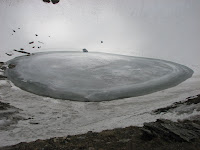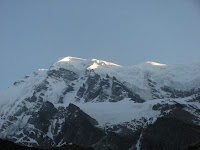We decided to start early but our guide said, it is better to start after the sunrise because the hard snow would melt which make it easy to walk. This is actually tricky, the snow should not have melted so much as to leave your shoes drenching and walking on very hard ice can be sometime dangerous as it can be like walking on greased roads. We left it to our guide to decide. This was early June and I had thought that we would hit snow at Bhagubasa itself, however till now we had not seen any signs of snow on the trail.
We finally started at around 7.15 AM when the sun was already shining. The initial climb was gradual and on the trail. After walking for about a kilometre, we saw first signs of the snow patches on the trail. We had an ice axe which was very useful for cutting the steps where required.

We were progressing very cautiously, because even a single wrong step and the whole trip for everyone would be in soup. We were now regularly cutting steps in the snow using the ice axe. We were carrying about 3 ice axes and it was indeed a very useful equipment. The whole trail is surrounded with huge mountains hence it was altogether a different experience. After one point the well-marked trail disappeared under heavy snow, so we followed our porters who had decided to clamber over the rocks. But this was not the correct route – it might have been ok for the porters but for us, it looked pretty precarious. We were climbing up on all fours on dangerously perched rocks. We got stuck at a point and did not know how to get out of this. We could see the lone guy from the other group looking at us from down below. He saw us in that condition and decided to return back from that same place.
Mahendar came to our rescue. He suggested that we try and climb upwards towards main trail. Some of us decided to clamber up the rocks itself . Sandeep tried to go towards the guide and at that point he slipped. He was now hanging on his hands with desperately trying to get his feet in place. I saw him in this condition and got the scare of my life, but immediately two porters went down and helped him up. It was only later that Ajay told me that he was looking at Sandeep from a few meters below and saw that the slip was more dangerous than any of us could imagine.
With all these adventures, it took us around 3.30 hrs to reach Roopkund (~15500 feet). All of us were extremely elated.



The best trekker amongst us was undoubtedly Ajay. He was the oldest among us but had a very strong determination and hoards of will power. We were all happy that we had managed to reach till Roopkund without any major incidences. We happily clicked some photos. I also cranked my neck up and looked at the Junar gali. It looked like it was about 400-600 feet above us. It also reminded me of the famous “Bottleneck of K2” which I had seen pictures of. Of course there’s no comparison, but that was the first thought I had.

The climb looked steep and the last part looked almost vertical. But I thought let me first enjoy the fact that we had made it till Roopkund, I would worry about the Junar Gali climb later.
We thanked our porters and guide. Our porters also did a small pooja.

Sandeep, JP and I went down from the ridge to the lake. The lake was completely frozen and there was no sign of any of the famed skeletons. JP tried to go a little further on the ice and ended up drenching his shoe in the cold water. This image of Roopkund reminded me of a perfect half fried egg :-). We spent about 20 minutes there and suddenly saw that some dark clouds had started forming over Junar Gali. Our guide said that it was time to move on and we should get ready for the crossing of Junar Gali.
It was almost plodding in soft snow for the first 200-300 feet and then we reached a point where we had to negotiate the rocks. Now was the part we had been really worried about. We had thought that we would need to fix up ropes here and then the climb should be done using the ropes. However, at this point, I would like to mention, our porters were the real heroes. Without fixing any rope, with the help of our porters we reached on top the Junar Gali and it had taken us all of under 30 minutes to complete the treacherous stretch from Roopkund. In the end, all of it looked so easy that I began to wonder why was there so much of a hype around Junar Gali. It was indeed a great feeling to be here on top at around 16000 feet.



We were the first group on Junar Gali for season. The feeling was exhilarating. This was the tough task and we had all done it together. We spent some time on the top. There are no views from Roopkund as the lake lies in a shallow crater like formation. However, the views from Junar Gali are great. The Mt Trishul ranges looked so close. JP being the faithful Yahoowala, clicked some photos of himself with the Yahoo banner.
While having some chocolates, I felt some snowflakes and that was an indication that the weather was turning bad. We immediately decided to go down. We all thanked the weather Gods for being with us; this climb would have been difficult if the weather had gone sour.
It has been my experience from the past three or four treks that I always feel happy after reaching the pass but after that the descent is always killing and sometimes more challenging than the climb to the pass itself. And the same was true for this climb as well. The descent from Junar Gali to Shila Samudra was a steep downward slope of about 1500 feet. As we started descending down we decided to use the ropes as the initial descent appeared to be very steep. The weather had now turned very bad and it had started snowing heavily.

All the porters went ahead. JP and a porter were going ahead of Sandeep and I. Rajeev was after us followed by Ajay with guide. There was a complete whiteout now and no trail was visible; everything was covered with snow. We were blindly going down. However, we had been in bad weather earlier and had seen such whiteouts during the Kalindi and Bara Bhangal treks. I even clicked some photos taking my camera out of my raincoat.
It took us about one and a half hour before we could see our camps down in the valley. I can’t express, it was such a big relief.
JP, Sandeep and I reached the campsite at around 1:30 PM.

To our surprise, there was another group which had camped there – a group from Bengal greeted us with loud claps. I had initially thought that the tents were of the “Keeda Jadi” guys, however it was indeed surprising to find another trekking group there. They served us hot soup, which was really needed after a long day. We had been walking for close to seven hours.
After talking to Bengali group, we came to know that, they had been trying for Ronti Saddle but had been unsuccessful in their last three attempts. So this time, they decided to do Ronti Saddle first and then climb over Junar Gali and reach Roopkund. They had successfully climbed to Ronti Saddle this year and they would be going to Junar Gali the next day.
We were waiting for Rajeev and Ajay – the weather had turned nasty now and we could not see anything towards Junar Gali. We knew Ajay was with guide but Rajeev was alone so we were little anxious about him. After sometime we saw Rajeev coming down with victory written all over his face. A few moments later, Ajay also came down. He was looking tired. His shoes had given him a tough time as he had slipped couple of times on the snow and rocks while coming down. He wanted to end the trek and go towards Sutol from here, but we all tried to convince him to be with us and in the end he agreed.
It was celebration time for all of us. We opened the Haldiram sweet packet , which we had got for this occasion from Gwaldam.
Shila Samudra literally means “Ocean of Boulders”. The campsite of Shila Samudra (~13500 feet) is at the base of one of the faces of Trishul. This the rock face and I am not sure if anyone has made an attempt of climbing Trishul from this face. We could see the huge icefall and the whole Shila Smaudra glacial moraine of Trishul ranges.

This campsite is also famous for another reason. The whole of the area around Roopkund is famous for different types of herbs. The most famous and popular amongst all these is the herb called “Keeda Jadi” in local language. One strand of this herb can be worth 100Rs. This herb is found in large quantities at this campsite. This is like gold for the villagers around this area who spend a lot of time looking for this herb amongst the melting snow and tall grasses. Our porters were happy at this campsite and I don't think they would have had any issues with a rest day at this place. They forgot they had to cook food etc, all of them went out hunting for Keeda Jadi.

In the evening we also saw a herd of Bharal (mountain goat), near our campsite. There were about 15 individuals in that herd. Before I could get my camera and click some photos, they disappeared in the snow pastures. Sandeep followed the herd for clicking some photos but the goats just disappeared in the snow and moraine.
It had been raining for a while in the afternoon and we all huddled in one tent. Rajeev is doctor by profession and it was nice to have a doctor on the trekking trip. For every small problem everyone used to bother him. In the evening, all of us poured out our health problems to Rajeev and got free consultation.
This was a wonderful day. One the way, we had met lot of trekkers going to Roopkund and believe me hardly any one of them made it till Roopkund. All of them dropped out much before reaching the lake. Before I came to Roopkund, I used to think that it should be possible for first time trekkers to be able to do it. Well I still think it is possible for first timers to come till Roopkund, it is not a difficult trek but a good amount of preparation is required. Trekkers have to fit physically and more so mentally to be able to come up till Roopkund.
Next Previous





















































